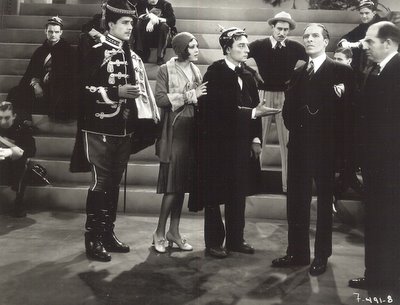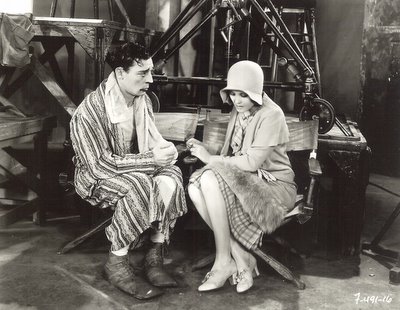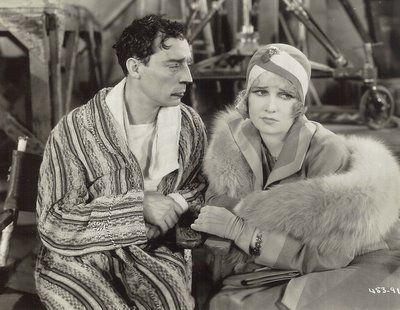



Buster Keaton In Transition --- Part 1
The Buster Keaton MGM features are a despised lot. With the exception of The Cameraman, and to a lesser degree, Spite Marriage, they are disregarded by fans as wholly unworthy of Buster, an unforgivable instance of big studio avarice brought to bear upon a maligned and misunderstood genius. While we certainly regret the loss of Buster’s creative independence, we also recognize that he was never wholly independent to begin with. Producer Joseph Schenck was the ultimate authority on the Keaton series, and though he was indulgent of Buster’s creative impulses, he was also, first and foremost, responsive to the will of the public and exhibitors. Keaton often spoke of how he made Seven Chances against his own better judgment, that it was a project "they" forced upon him. "They" also assigned a production supervisor on his last United Artists feature, Steamboat Bill Jr., which, contrary to previously published Keaton scholarship, did show a profit, according to the producer’s settlement statement. With a negative cost of $386,000, Steamboat realized domestic rentals of $375,000, with additional foreign revenue of $347,000. Worldwide total was $722,000 (only slightly less than the $749,000 taken by the previous Battling Butler, a picture Buster cited later as one of the most financially successful of his career). The final tally for Steamboat showed a profit of $67,555. It’s true Buster would never strike lightning the way Chaplin or Lloyd could, but there’s every reason to believe that all three of his UA releases --- The General, College, and Steamboat Bill Jr. --- made money, and it’s unfortunate they’ve been branded as failures as the result of careless research. Also regrettable was the fact that Joe Schenck chose this time (1928) to unload Buster’s contract. There’s no question Schenck was overextended, what with wife Norma Talmadge’s vehicles and his Art Cinema ventures. The producer had managed to link himself with a number of high profile independent productions, and the profit potential in disposing of Keaton’s services was no doubt irresistible to him. In hindsight, Schenck’s Metro deal for Keaton was clearly a mistake, but that’s because we know and understand Buster so well. Back then, no one had a handle on what made Buster tick. Not even Buster. Chances are he saw this Metro deal as a good thing. How could he know what they’d end up doing to him? Chaplin advised against it, but Buster knew all too well he’d have to go to work for somebody, unlike Charlie, who answered only to himself. The money was a powerful inducement --- $3000 a week. Bear in mind, this is a man with a luxurious Spanish Villa to keep up, along with a free-spending wife on the verge of throwing him out. How do you turn down $3000 a week when you’ve got two young children, plus your own parents and siblings hanging around your neck? It would have been great if Buster could have gotten another independent producer to put together a comfortable, and autonomous, working arrangement for him, but we know Buster wasn’t good at that sort of deal-making, and besides, MGM was promising essentially the same thing under their stewardship. They certainly didn’t plan on sabotaging his career. It was just one of those things that … happened. Relations seemed to get off to a good start, anyway. The Cameraman was at least an artistic triumph. You can see the dreaded "Elmer" peeking in, but there’s still enough Buster, stalwart and resourceful, to remind us of the glory days. Problems arose when receipts were tallied. The Cameraman, with it’s $362,000 negative cost, brought back only $362,000 domestic, and though foreign was excellent ($435,000), the worldwide at $797,000 (with eventual profit of $67,000) suggested that Keaton might need closer handling. Spite Marriage, which came next, saw an alarmingly increased Elmer presence ("Elmer" was the ever more bungling character Buster would be obliged to play in all his Metro features), and it was clear the old Keaton was slipping away. This feature was cheaper than The Cameraman at $282,000, but domestic rentals for Spite Marriage stopped at $345,000. These North American numbers fell below the United Artists features, and it took considerable foreign revenue ($556,000) to bail out Spite Marriage, with a final profit of $197,000. This might have been considered an acceptable return, until you consider the kind of profits Metro was getting with the Chaneys, Garbos, Gilberts, Novarros … even a new star like Joan Crawford was pulling much more than Buster. Most sobering is the fact that in the area of comedy, MGM’s second tier series of Karl Dane/George K. Arthur laughers were actually more reliable, and profitable, than the Keatons.
Buster’s first talkie, Free and Easy, picked up $438,000 domestic, but lost ground in foreign with $437,000 (there was a silent version issued, but the fact that this was sold as a talker may have cut into overseas receipts). The much increased negative cost represented a hazard, and a final worldwide total could only yield a stated $32,000 in profits. No wonder Buster was being pulled in so many creative directions! The success of his pictures in overseas markets suggested the possibility of foreign language versions. This meant he got to make the same movie at least twice, and in the case of Free and Easy, he was obliged to speak Spanish phonetically, since, as far as we know, Buster was not fluent in the language. The English version of Free and Easy was shot from November 21 to December 26, 1929, a 31-day schedule with one day of retakes, and released March 22, 1930. Estrellados (the Spanish version) was released some months later on July 22, 1930, at a negative cost of $99,764, less because it was not necessary to reshoot every scene in Spanish. It is obvious that the original MGM profit and loss sheets do not contain the foreign language negative cost figures. If we incorporate the negative cost of Estrellados into our profit and loss calculation, we will ultimately show a loss for Free and Easy of $67,557. The only foreign language version of Free and Easy was the Spanish edition. Variety reviewed Free and Easy with French sound on January 28, 1931, but this was a dubbed print, as no actual French language version was filmed. The stills we have here are of both the English and Spanish Free and Easy. We see Buster with Anita Page in a scene from the English version, and in the same scene repeated months later with Raquel Torres, his Spanish leading lady. There is also Buster in a group with Spanish speaking cast members, filling in for American players Robert Montgomery (his role is played by Don Alvarado, who later appeared in La Cucaracha) and Fred Niblo. Note the "f" preceding the still number in the lower right hand corner of the still. That’s the identifier for the foreign version of Free and Easy. Finally, we have one of those nice and friendly cast-holding-the-slate poses that were so familiar in those days. That’s Bob Montgomery and Anita Page with Buster. There would be two more Keaton Metro features with foreign versions, Doughboys and Parlor, Bedroom, and Bath. Check in over the next few days for the coverage on them.
Please note that the foregoing account of Buster Keaton’s late silent and early talkie career would not have been possible without the very knowledgeable input, advise, and corrections of Dr. Karl Thiede, a Keaton scholar who has spent the last thirty-five years gathering information on the great comedian, and has very generously shared it with us for this project.
0 Comments:
Post a Comment
<< Home